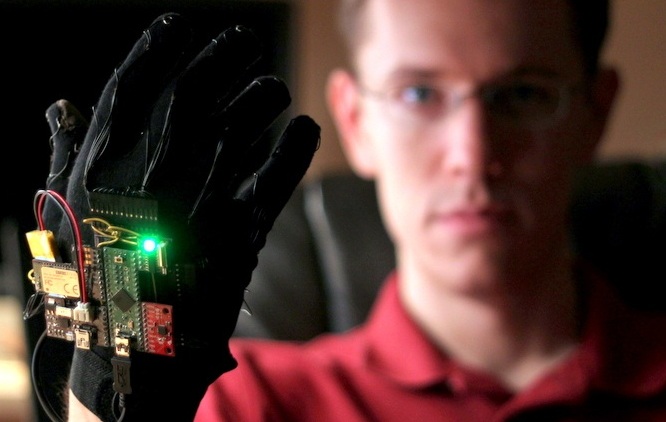Podcast: Play in new window | Download
Subscribe: Apple Podcasts | RSS
Welcome, Jeff Rowberg of Bluegiga Technologies and the KeyGlove Project!
- BlueGiga has a proprietary BT stack called the iWRAP stack
- Bluetooth itself has a bunch of different profiles. Some of the ones discussed were:
- HID – Human Input Device
- SPP – Serial Port Profile
- Sparkfun now carries some that are single profile devices, such the BlueSMiRF Gold
- These are based off modules by Roving Networks
- There are 2 halves of a BT stack
- Controller (the radio and HW)
- Host (network interface)
- Most communication wi
th the modules is through a UART connection. - The BlueGiga modules use the CSR chips BlueCore line. This is an XAP processor and the low level utilizes the BlueLab dev environment.
- Chris asked about the TI family, such as the CC2541 by Texas Instruments. This is actually integrated on other BlueGiga modules.
- Jeff has been selling breakout boards through InMojo, a marketplace site for OSHW. It preceded but is similar to Tindie.
- Chris points out that Jeff made the unusual transition from software to hardware. Jeff blames the Arduino and the face that his dad was an EE.
- Growing up, Jeff worked on TRS80 and Graymark kits with his father and brother.
- The KeyGlove project was not directly influenced by the Nintendo Power Glove. This was prominently “featured” in the 1989 film, The Wizard.
[tube]http://www.youtube.com/watch?v=AacoxHFYvZw[/tube] - Jeff is interested in wearable computing (obviously) and is in the Google Glass Explorer program, same as Chris.
- It was at the Google I/O “Voiding your warranty” session where he decided to start hacking at getting the KeyGlove to interface to Glass.
[tube]http://www.youtube.com/watch?v=OPethpwuYEk[/tube] - Windows 8 has an odd way of adding unsigned drivers, which the Android environment is right now for Glass.
- The KeyGlove kickstarter is still working on delivering prototype units, nearly 2 years later.
- Keyglove fabric interface is tough. Chris suggests Jeff talked to Hoeken about his keyboard pants. Jeff has talked to Lynne Bruning in the past about conductive fabrics.
- Aside from working on KeyGlove and at BlueGiga, Jeff has also been working on a standardized library for interfacing to I2C parts with not-so-transparent registers. This is all documented at i2cdevlib.com.
- The device that started it all was the Invensense MPU6050.
- It has been co-developed with Noah Zerkin, who is a wearable computing enthusiast. He also was the one to take the picture of Sergey Brin wearing Glass on the NYC subway.
- Debugging and reverse engineering the I2C bus was assisted by the Saelae logic analyzer by watching a dev board boot and monitoring packets between the dev board micro and the chip.
- The database driven register map is a great way of visualizing register sets, without using Excel.
- All code for this open source project can also be found on GitHub. People are also working on porting to other devices like the MSP430.
- When asked about why Google doesn’t already have Bluetooth Low Energy support, Jeff guessed it was because they were counting on the alternate standard, ANT+which never took off.
Many thanks to Jeff for answering all of our questions about Bluetooth and interfacing with modules that implement the standard! Follow Jeff on Twitter, @SectorFej.


Hey guys, I’m confused… Jeff mentioned that BlueGiga doesn’t have a dual mode module. Am I missing something or is this not a dual mode module??? http://www.bluegiga.com/bt111
Hi Buddy,
I should have been more specific about the dual-mode module. The BT111 is indeed a dual-mode module, but it only has the controller portion of the Bluetooth stack and is an HCI-only module, accessible over USB but requiring the host portion of the stack running (e.g. Broadcom, BlueZ, BTstack, etc.) on the host device. It is not like the WT12 (classic Bluetooth with iWRAP stack) or the BLE112 (Bluetooth Low Energy with IWRAP stack), both of which are totally self-contained and controllable over UART. We do have the HCI-only BT111 dual-mode module, but not a full-stack dual-mode module at this time.
Timing couldn’t have been any better, I was listening to this episode on my nexus 4, My nexus 4 received major android 4.3 Jelley bean OS upgrade few hours earlier and the new upgrade has BLE support.
CSR and TI has post on it.
http://www.csr.com/blog/2013/07/developing-bluetooth-smart-accessories-android
http://e2e.ti.com/blogs_/b/connecting_wirelessly/archive/2013/07/24/how-to-get-started-on-bluetooth-smart-for-android-4-3-jelly-bean.aspx?DCMP=jul24-blog&HQS=jul24-blog-sm